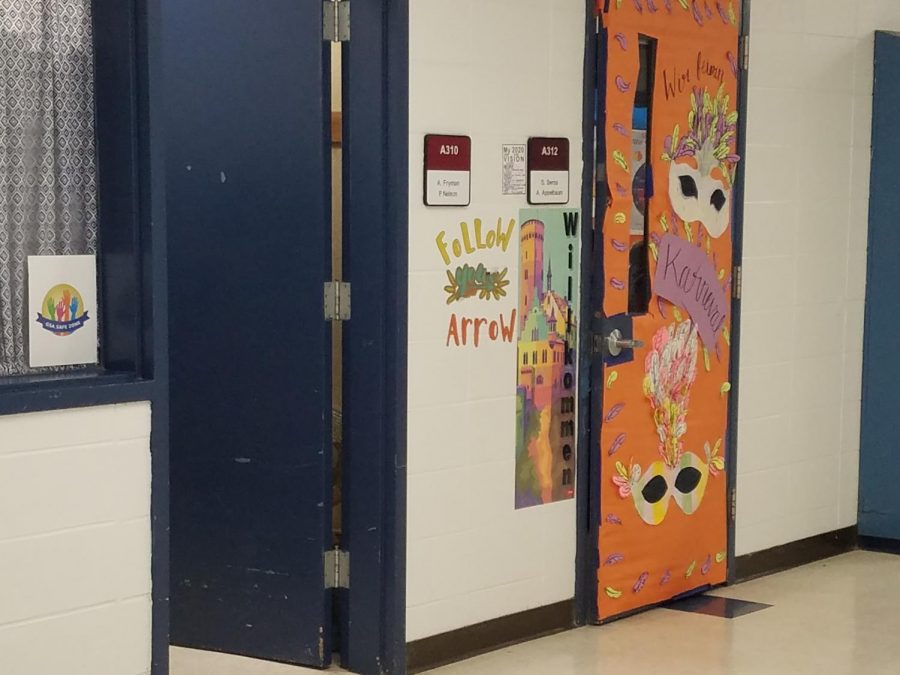Open, Closed or Cracked?
Some teachers keep their doors open, some keep them cracked, and others keep them shut.
There are several factors in everyday life that can affect the learning of students and the teaching of teachers. However, a huge determining factor of how well a student learns or how well a teacher is able to teach is the environment that is around them. It might be hard to believe, but the slightest things, such as the position of the classroom door, can affect learning and teaching in many different ways. The job of a student in the school is to learn. However, a small disturbance from outside the classroom can have a large effect on whether or not a student is able to complete this task.
“I like the door closed because when it is open it creates a distraction,” said Taelyn Mapes (‘23).”Every time someone walks in the door, the whole class will look over in that direction. It disturbs the whole class.”
It is definitely a distraction to hear the door open and close all hour as students enter and exit. However, this disturbance may be unavoidable at times. Despite negative impacts on learning, having the door slightly open may not always be a bad idea.
“I would say I want the door cracked,” said Jackson Kamienski (‘23).”
It lets some air into the room, isn’t dry or hot.” Temperature is another factor that can affect learning. If a classroom is too hot, a student not be focusing on the topic they are learning about. They will instead be focusing on how to stay cool.
Teachers, though they are able to teach in most scenarios, also may have a preference as to whether the door is open, closed, or cracked while teaching.
“I prefer teaching with the door all the way open because I like the see the students out in the hall,” said Mrs. Nichols. “However, I keep the door closed so I don’t disturb other classes.”
“I want the door closed,” said Mr. Davis. “ I don’t like the distraction that comes from the halls and other classrooms.”
“Shut,” said Ms. Swanson. “It lessens disturbance if people like making noise in the hallways or if our classroom is too loud.”
It seems that there is no common opinion shared by teachers either. Some don’t like disturbances from the hall and other classrooms, some don’t like to disturb people in the hall and other classrooms.
But what of the actual statistics? During the sixth hour, the data seemed to be split as well. In the A400 hallway, about 67 percent of classroom doors were open while teaching was in session.
This may have something to do with the fact that the A400 hallway, is generally not a very busy hallway unless it is during a lunch hour. In the A300 hallway, the results were fairly close. About 28 percent of the doors were open, 39 percent of the doors were closed, and 33 percent of the doors were cracked. The closeness of data may be partially attributed to the size of the A300 hallway.
Because of its great size, some parts of the hallway are busy and others are not. In the A200 and A100 hallways, the majority of the doors were cracked, A100 having 60 percent and A200 having 75 percent. There are two main factors that likely carry an explanation for these numbers. First of all, these two hallways have the least amount of classroom doors. Second of all, these hallways are central hallways and might get a bit of distraction from the hallways.
The conclusion gathered from the process was that the door position of a classroom all comes down to a matter of preference. Results can vary depending on the person asked or hallways surveyed. Preferences for learning or teaching depend on the personal needs of the specific person, and not so much relating to statistics.













ty williams • Mar 6, 2020 at 7:55 AM
when its hot in a classroom I cant work but i say the door she be cracked that way its not always to hot in a room
Colin Schultheis • Feb 28, 2020 at 7:37 AM
I can really relate to the temperature factor because when it’s too hot in a classroom I can’t focus on my work